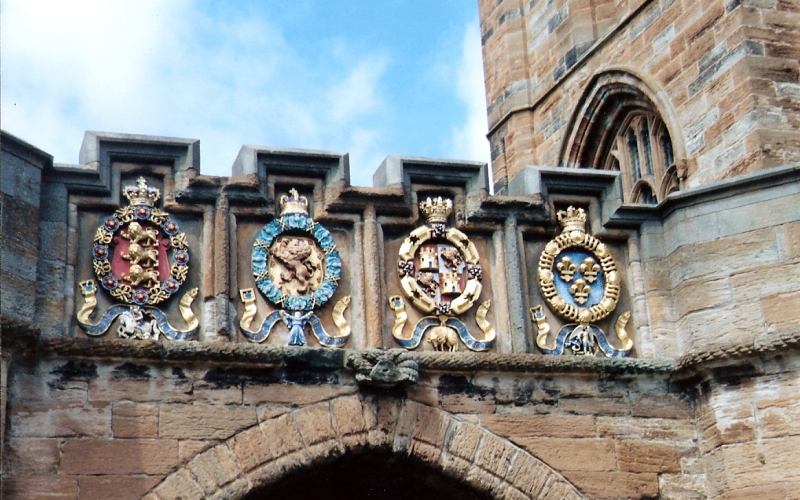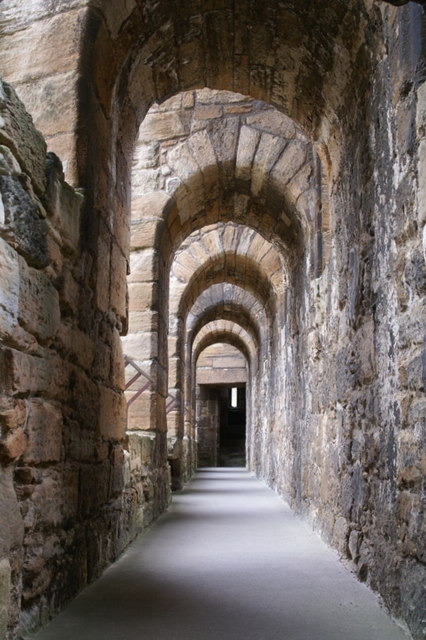
Vivid blue sky greets us as we arrive in Linlithgow, five miles north of Torphichen. Here is another bustling town. We weave our way through traffic and park in a car park near the Palace. The ultramodern spire of St. Michael's Church towers above us – a highly polished steel thing that makes me screw up my face in bewilderment. I think of the Angel of the North and shake my head; to each their own.
Around a planted area and up a hill we climb. This is a good thing, this hill. Since conquering Walltown Crags and the Wallace Memorial I've looked forward to a good steep hill to climb each day. My calves and ankles may make a hint of complaint, but the exercise is wonderful and the weather is perfect for it; highs in the mid- to upper-sixties, big puffy white clouds that form and reform, and a slight breeze.
The outer gate looms over us, the decorative crenellations and ropes bordering four brightly painted heraldic medallions. These are the arms of the four orders of chivalry to which James V belonged: the Garter of England, the Thistle of Scotland, the Golden Fleece of Burgundy, and St. Michael of France.
If I needed a reminder that I was about to visit a Palace as opposed to an abbey or a castle, the outer gates have certainly served that purpose. Not unlike the brightly colored restoration work that has been completed in the Great Hall at Stirling Castle, these arms of honor are impressive in their mastery. Should the ghost of James V be about, I'm sure that he is pleased that they have been tended with such care.
Showing our passes at the admission area, we pass out into the courtyard. Here is the fountain Robin has told me so much about. Built around 1538 it flowed with wine at royal weddings. The carvings on this fountain are magnificent and I circle around and around, zooming in, kneeling down, clicking away, taking shot after shot. I look up to see Robin and Dana disappearing through a doorway and rush to catch up.
Constructed over the course of little more than a century, the building of the Palace was begun by James I in 1425 and completed in 1538. We wander through the hushed rooms; kitchens, Great Hall, drawing rooms, bed chambers. There are other visitors here, but the Palace is so vast that I get the impression we could wander for hours and not know they were here if it weren't for the eerie echoing of voices through the passageways.
I set off up a dark spiral staircase, peeking out windows as I pass them to gauge my progress. When I look out and see the catwalk that runs around the perimeter of the palace I sit to catch my breath. Oh, what a view. Not of the countryside, but of this incredible structure. What a sight it must have been to see during its heyday. Back down the stairs I go, choosing my footing carefully in the dim light.
Back out in the courtyard I take a seat on a bench in the sunshine next to Dana. Robin has climbed to the roof and yells down to us "Take my picture!" She's up so high up, she looks tiny in my view finder.
At this time two preteen girls in period dress come into the courtyard; two young Mary Queen of Scots. One is dressed in the finery of the day and the other is dressed in a wedding gown. I smile as they sit on a bench nearby talking quietly, but with great animation, to each other and trying on each others' headdresses. A family approaches and the girls pop right up off of the benches to pose for photographs. I wonder if this is some sort of rite of passage for the young girls in Linlithgow, to portray Mary Queen of Scots at the Palace for the tourists who visit here.
After a tour around a museum-like exhibit we leave Linlithgow behind. Robin needs to phone Rena and Martin to make arrangements for us to meet this evening. Off we go into Linlithgow, which is still merrily bustling away. Robin finds a phone box straight off and is soon engaged in conversation with Rena.
Dana and I meander around a bit, then head back to the car where we lean against the bumper talking and smoking (cough) for what seems to be a long while. Hmm ... maybe Robin is waiting for us back by the phone. We wander back to the walkway where we can peer out over the street. Nope, she's still chattering away.
The sun is bright and warm and I'm starting to feel the effects of my midnight ramble around Melrose. Just when I'm about to fall asleep on my feet, Robin appears. She's had a great talk with her friend and is so excited that we're all going to be meeting for dinner. Her enthusiasm is contagious and I find myself roused from my drowsiness.
As we head off toward the west, I'm looking forward to meeting Rena, Martin and "Big Bad" Jim; and more of Robin's friends as well – Penny and Frank, hosts of Oaklands Bed & Breakfast in Laurieston.

The ruins of Linlithgow Palace are situated in the town of Linlithgow, West Lothian, Scotland, 15 miles west of Edinburgh. The palace was one of the principal residences of the monarchs of Scotland in the 15th and 16th centuries.
In 1424, the town of Linlithgow was partially destroyed in a great fire. King James I started the rebuilding of the Palace as a grand residence for Scottish royalty.
Mary, Queen of Scots, was born at the Palace in December 1542 and occasionally stayed there during her reign. The daughter of James VI, Elizabeth of Bohemia, lived in the Palace.
After the Union of the Crowns in 1603 the Royal Court became largely based in England and Linlithgow was used very little.
Read more about Linlithgow Palace at Wikipedia.